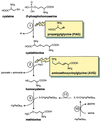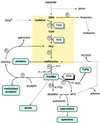The specific features of methionine biosynthesis and metabolism in plants
- PMID: 9636232
- PMCID: PMC22764
- DOI: 10.1073/pnas.95.13.7805
The specific features of methionine biosynthesis and metabolism in plants
Abstract
Plants, unlike other higher eukaryotes, possess all the necessary enzymatic equipment for de novo synthesis of methionine, an amino acid that supports additional roles than simply serving as a building block for protein synthesis. This is because methionine is the immediate precursor of S-adenosylmethionine (AdoMet), which plays numerous roles of being the major methyl-group donor in transmethylation reactions and an intermediate in the biosynthesis of polyamines and of the phytohormone ethylene. In addition, AdoMet has regulatory function in plants behaving as an allosteric activator of threonine synthase. Among the AdoMet-dependent reactions occurring in plants, methylation of cytosine residues in DNA has raised recent interest because impediment of this function alters plant morphology and induces homeotic alterations in flower organs. Also, AdoMet metabolism seems somehow implicated in plant growth via an as yet fully understood link with plant-growth hormones such as cytokinins and auxin and in plant pathogen interactions. Because of this central role in cellular metabolism, a precise knowledge of the biosynthetic pathways that are responsible for homeostatic regulation of methionine and AdoMet in plants has practical implications, particularly in herbicide design.
Figures





Similar articles
-
Methionine metabolism in plants: chloroplasts are autonomous for de novo methionine synthesis and can import S-adenosylmethionine from the cytosol.J Biol Chem. 2004 May 21;279(21):22548-57. doi: 10.1074/jbc.M313250200. Epub 2004 Mar 15. J Biol Chem. 2004. PMID: 15024005
-
Current understanding of the factors regulating methionine content in vegetative tissues of higher plants.Amino Acids. 2010 Oct;39(4):917-31. doi: 10.1007/s00726-010-0482-x. Epub 2010 Feb 6. Amino Acids. 2010. PMID: 20140469 Review.
-
Metabolism of sulfur-containing amino acids.Annu Rev Nutr. 1986;6:179-209. doi: 10.1146/annurev.nu.06.070186.001143. Annu Rev Nutr. 1986. PMID: 3524616 Review.
-
The structure of the C-terminal domain of methionine synthase: presenting S-adenosylmethionine for reductive methylation of B12.Structure. 1996 Nov 15;4(11):1263-75. doi: 10.1016/s0969-2126(96)00135-9. Structure. 1996. PMID: 8939751
-
A substrate switch: a new mode of regulation in the methionine metabolic pathway.J Theor Biol. 2000 Jun 21;204(4):521-32. doi: 10.1006/jtbi.2000.2035. J Theor Biol. 2000. PMID: 10833353
Cited by
-
S-Adenosylmethionine Synthetase 3 Is Important for Pollen Tube Growth.Plant Physiol. 2016 Sep;172(1):244-53. doi: 10.1104/pp.16.00774. Epub 2016 Aug 1. Plant Physiol. 2016. PMID: 27482079 Free PMC article.
-
Involvement of BcStr2 in methionine biosynthesis, vegetative differentiation, multiple stress tolerance and virulence in Botrytis cinerea.Mol Plant Pathol. 2016 Apr;17(3):438-47. doi: 10.1111/mpp.12292. Epub 2015 Sep 18. Mol Plant Pathol. 2016. PMID: 26176995 Free PMC article.
-
Comparative protein profiles of Butea superba tubers under seasonal changes.Mol Biol Rep. 2016 Jul;43(7):719-36. doi: 10.1007/s11033-016-4010-2. Epub 2016 May 19. Mol Biol Rep. 2016. PMID: 27198528
-
One-carbon metabolism in plants. Regulation of tetrahydrofolate synthesis during germination and seedling development.Plant Physiol. 2003 Mar;131(3):1431-9. doi: 10.1104/pp.016915. Plant Physiol. 2003. PMID: 12644692 Free PMC article.
-
Proteomics of Arabidopsis seed germination. A comparative study of wild-type and gibberellin-deficient seeds.Plant Physiol. 2002 Jun;129(2):823-37. doi: 10.1104/pp.002816. Plant Physiol. 2002. PMID: 12068122 Free PMC article.
References
Publication types
MeSH terms
Substances
Associated data
- Actions
LinkOut - more resources
Full Text Sources
Other Literature Sources
Molecular Biology Databases

